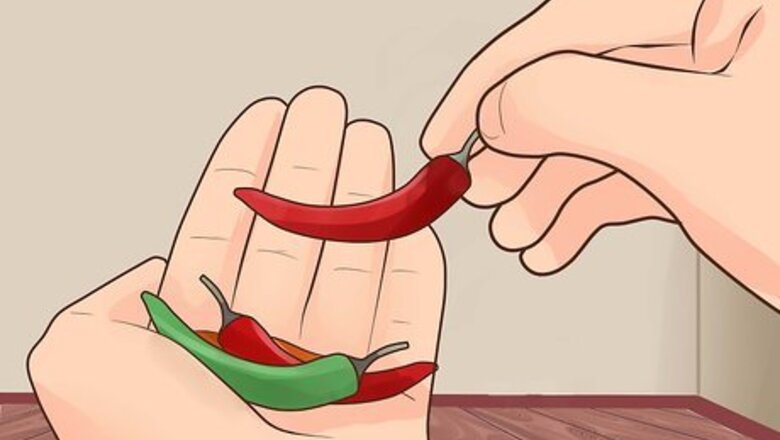
views
How to Germinate and Sow Chilli Seeds

Choose a variety of chilies. Chilies are one of the most wonderful plants to grow because they come in a wide range of colors, sizes, tastes, and spice levels. Three general types of chili include sweet, hot, and ornamental. All types have some spice level, but sweet chilies are the mildest, ornamentals have lovely colors and shapes with a kick of spice, and hot chilies are used primarily for their intense spice levels and flavors. Chillis come in both annual (meaning you have to replant them each year) or perennial (meaning they grow back on their own) varieties. Colors range from green, butter yellow, peachy orange, and fire-engine red to plum and pitch black. The colors, however, don’t directly correlate to the flavor or spice levels. Visit a local nursery to discover what variety will thrive in your local environment. Certain chilies are used in different areas of the world for special recipes; for example, Serrano chilies are used primarily in Mexican dishes, while the Calcutta pepper is used in Asian curries.
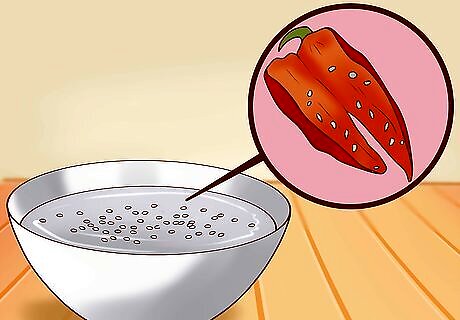
Soak chili seeds in lukewarm water to aid germination. Soften the seeds by wrapping them in a lukewarm paper towel to encourage growth. Place the cloth with seeds into a plastic bag. Then, store the bag in a dry, warm place, like a cupboard, for 2 to 5 days.
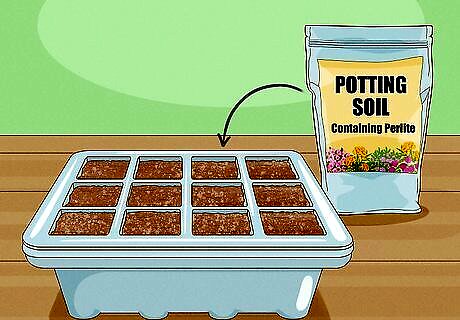
Fill seed trays with moistened seed start mix. After soaking your seeds, combine an aerated seed starter mix with water to moisten the soil. Start with a small amount of water and mix the material with your hands to distribute it evenly. Use gloves if you don't want to get dirty. Add the prepared starter to the seed tray (cells). Compress the mixture with your fingers. If you squeeze the mixture and water seeps out, the mixture is too wet. Add more soil.
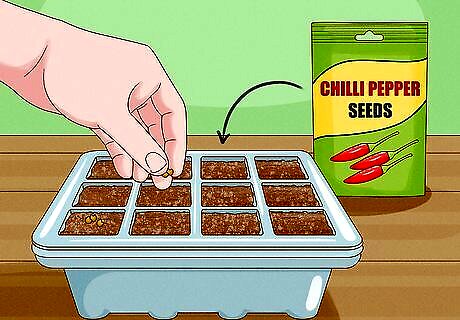
Sow 2-3 seeds per cell and let them germinate for 14 days. Sowing refers to scattering the seeds onto the soil. Place 2 to 3 chili seeds into each cell. Then, use your finger or the pencil tip to bury the seeds ⁄4 in (0.64 cm) deep. Generously mist each cell and place the tray in a warm area with a plastic cover to contain the heat. To germinate the seeds, you may need a heat mat to maintain 80 to 90 °F (27 to 32 °C). Fan out the trays once a day for a few minutes to add oxygen. Moisten the seeds as they dry out, but don't add too much water, as overwatering can lead to mold. Sow chili seeds indoors from late winter to mid-spring for a longer harvest.
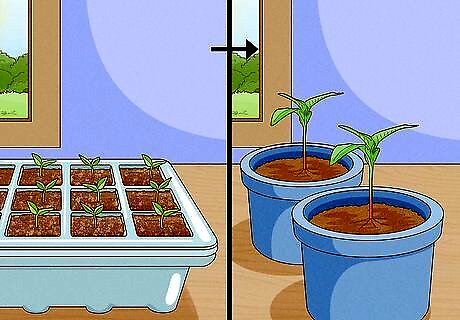
Transfer the seedlings into new soil after 7 to 14 days. Wait for the seeds to sprout. This should take between 7 to 14 days. However, some chili varieties can take up to 3 weeks to sprout. Look for 2-4 sets of leaves before repotting them indoors or outdoors. Use sharp scissors or clippers to trim the weaker seedlings.
How to Plant Chillis Indoors

Fill a ⁄4 in (0.64 cm) pot with potting soil. Start with a small pot for the first transplant. You can always repot the chili as it gets bigger to encourage more growth. Use rich, high-quality potting soil with compost for added nutrients. Fill the pot with at least 2 in (5.1 cm) of soil. You can also use any indoor fertilizer to enrich the chillis every couple of weeks. Alternatively, you can use a large planter basket for a balcony. For houseplants, use a small chili variety so it can grow efficiently. If you don't have enough light, purchase a plant light.
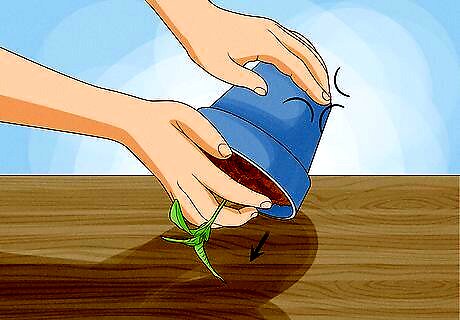
Remove the seedling from its cell. Place your hand over the base of the individual cell tray and gently pop the starter out, or use a spoon to loosen the sides of the cell tray. You could also gently pull the seedling and root ball from the cell, careful not to tear or damage the roots.
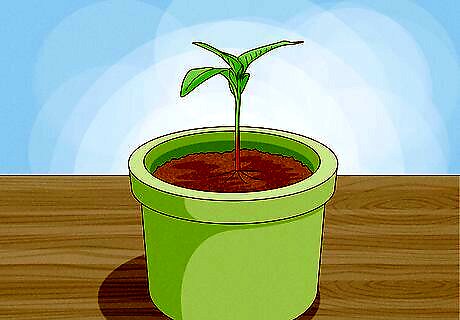
Transfer the seedling to its new pot and cover it with soil. Transfer the seedling to the larger pot you prepared with soil. Hold the seedling steady with one hand, and add enough potting mix to cover the root ball and stem. The stem should be able to stand steadily on its own. Cover just below the first set of leaves. If possible, prepare your soil weeks or months in advance so your chilies can grow better. They prefer soil that has good drainage and plenty of nutrients. Add a bit of sand into your soil to help it drain better, and incorporate compost a few weeks or months before planting. Always test your soil first to ensure it has enough potassium. Chillis like soil with a neutral or slightly acidic pH of 6.5-7.
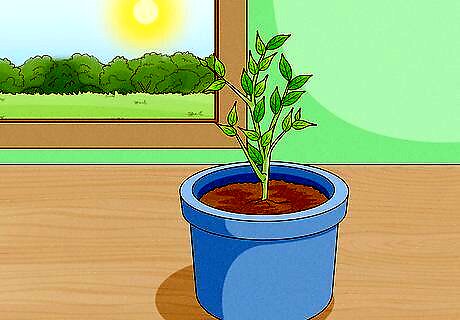
Put the pot in a place that gets 6 to 12 hours of sunlight. Move the potted plant to an area with direct sunlight, like next to a window, to keep it warm and healthy. However, if the leaves look burnt or wilted, it may be getting too much sun. Move the plant to an area with indirect sunlight.
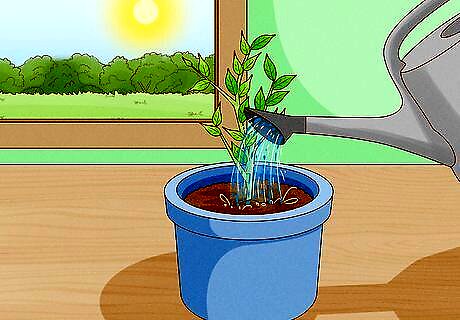
Water the soil as it dries out and check it daily. Chillis thrive in damp, but not soaked, soil. Allow the soil to dry out slightly between waterings to avoid overwatering the plant and prevent rot or fungal growth. Plus, the less water you use—the spicer the chili!
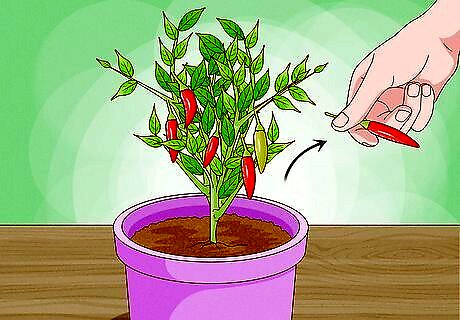
Wait up to 6 months for the plant to mature and bear fruit. It takes approximately 3 months from sowing to flowering. However, it takes an additional 3 months for the chilies to mature. This all depends on the variety of chilies and the environmental circumstances. Popular chili varieties include jalapeño, tabasco, cayenne, and habanero.
How to Plant Chillis Outdoors

Wait to plant outside until after the last frost of spring. Depending on your local weather, this is usually March or April in the northern hemisphere. Opt for a sunny day in the late morning or early afternoon when it's not too hot to avoid transplant shock.

Place the chillies outside for 2 hours a day to harden them. While you wait for the perfect sunny day to plant your chillis in the ground, start by hardening them. Seeds grown indoors have a consistent temperature. When quickly transferred outdoors, they can experience shock from varying temperatures, moisture levels, and sunlight. Sit them outside for 2 hours a day for one week, then add an hour to each additional day until they can be outside for 24 hours.
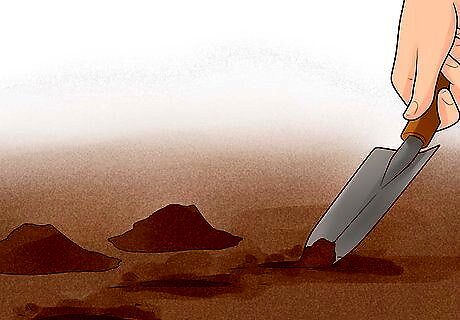
Dig a hole slightly larger than the seeds, spacing them 1 ft (12 in) apart. Plant your chilies individually to avoid overcrowding them. Use a garden trowel to dig a small hole in your garden. Make sure to provide enough space for the variety of chili you're growing. Alternatively, you can plant them individually in 5-gallon grow bags.
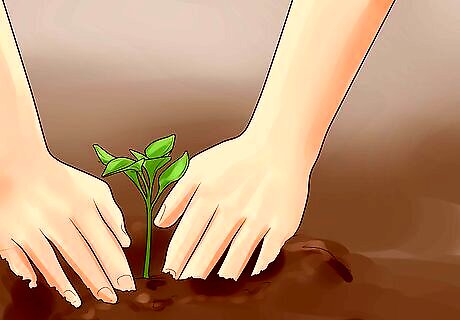
Plant each chili seedling into a hole. Gently lay the chili root ball into the hole you dug. Replace the soil over the top of each, so only ⁄4 in (0.64 cm) of soil is on top of the roots. Don't tamp or press down on the soil too much. Chilies grow better in loose, well-draining soil.
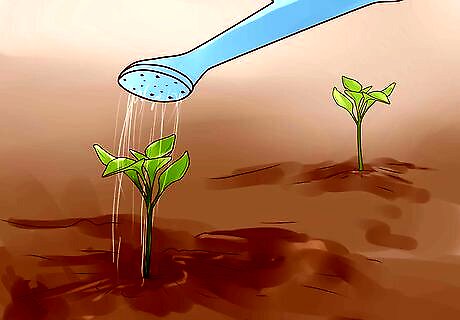
Moisten the soil daily. Chilies thrive when their soil is moist but not soaking wet. After the first planting, give them extra water to avoid transplant shock. Then, water them daily so the soil stays damp. If you're growing sweet peppers, give them more water to make them sweeter.
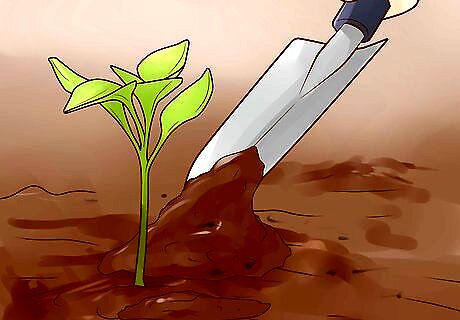
Weed and fertilize while you wait for the plant to flower. Pull out any weeds to ensure the plant grows quickly, as these can steal space and nutrients from your chilies. Add compost or potassium fertilizer every month to feed the chilies. You can also add a layer of mulch to lock in moisture so the chilies can begin to flower and bear fruit sooner. Depending on the type of chilies you're growing, you may need a trellis or stick to take on its weight. For example, bell peppers grow better with the support of a trellis.
How to Care for Chilli Plants
Maintain temperatures between 60 to 80 °F (16 to 27 °C). Whether you're growing them indoors or outdoors, chillis and other pepper plants grow best in warm climates with well-draining soil. Ideal temperatures for chillis to thrive are between 70 to 80 °F (21 to 27 °C) by day or 60 to 70 °F (16 to 21 °C) by night. If the temperature drops lower, use plant lights or heat mats to keep them safe. Temperatures above 90 °F (32 °C) may cause the plant to droop. During winter, transfer outdoor plants to pots and move them indoors or to a heated greenhouse.
Coat the leaves with soapy water and oil to prevent bugs. Two bugs absolutely love chili plants: aphids and spider mites, which can kill your plant. A DIY solution is to whisk together 1 US tbsp (3.0 tsp) of Dawn dish soap, 1 US tbsp (3.0 tsp) of vegetable oil, and 1 US gal (130 fl oz) of warm tap water in a bucket. Use a damp cloth to wet the leaves every 4 to 7 days until the infestation is gone. Alternatively, you can use a safe pesticide for your plant.
Plant flowers or herbs to attract ladybugs and get rid of pests. Despite their cute appearance, ladybugs are predators of pests. They love to eat aphids and other bugs that kill your chili plant. Plant flowers like marigolds, geraniums, or alyssums to attract ladybugs to your garden. Or plant herbs like cilantro, parsley, thyme, and dill.

Prune perennial chillies in the autumn. Cut back decisively, leaving a few main branches to encourage a solid structure. Try to leave 3 to 4 main branches and clip all the foliage. Transfer the clippings to a small jar with 1 in (2.5 cm) of water to sprout new roots for potting.
How to Harvest and Store Chillis
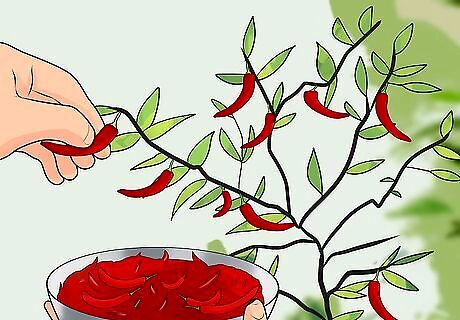
Harvest chilies during dry weather and cut from the stem. Color is the biggest indicator of when to harvest your chills. The color will begin to change from the top of the pod down. Wait until the color has completely changed for 3 to 5 days before harvesting. Then, select one chili and snip it in the middle between the stem and plant. Taste before harvesting more. Harvest jalapeños once they turn dark green. Harvest banana peppers when they’re a dark yellow, orange, or red. Cherry, habanero, and poblano are ready when they turn red. Use sharp scissors or clippers to snip the stems above the peppers. Wear gloves when handling chilies and wash your hands afterward to avoid transferring the hot oil to your skin, face, or eyes.
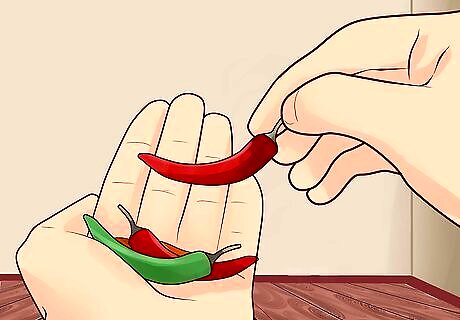
Freeze chillis for 6 months to store them. Chillis can be frozen with or without their stem intact. With a pair of gloves, wash and dry the chillis. Then, leave them whole or cut them into thin slices and place them inside a resealable bag. It’s up to you whether or not you want to take the seeds out. Alternatively, you can slice chillis very thin and stuff an ice cube tray with them. Add a small amount of water to each cube tray. When you’re ready to use, pop a cube out and add it to your dish!
Dry your chillis to make them last 1 to 2 years as flakes or powder. Wearing a pair of gloves, wash and thoroughly dry your chillis. Cut each chilli in half lengthwise and place them with the cut half up on a tray. Put the tray in a dry, dark room or by a hot water cupboard. Check the chillis every few days until they’re shriveled and completely dried. Slice them into small bits to turn them into flakes or use a blender to make a powder. Alternatively, you can tie each chilli to a long string and hang it in a dry place as if you were drying out flowers. You can also use a dehydrator set to 135 to 140 °F (57 to 60 °C) for 5 hours.
Pickle your chillis to make them last 6 months. The great thing about pickling is that you can add any additional flavors to the brine, including garlic, onion, and black pepper. Simply boil vinegar, water, pickling salt, and sugar together. Pour the solution over the peppers in a jar. The amount of each ingredient varies depending on how many pounds and the type of pepper you use. Wear gloves when handling chilies to avoid burning your eyes.
Can chillis in oil to last 1 to 6 months. Rinse and thoroughly dry chillis while wearing gloves. Then, slice and chop the chillis to fit into the jar. Combine 1 tbsp (18 g) of salt, 250 mL (8.5 fl oz) of vinegar, and 250 mL (8.5 fl oz) of oil and soak the chillis overnight. Drain the chillis by pressing down on them as much as possible with a plastic sieve. In a jar, add the chillis and top it with extra virgin olive oil. Allow it to sit for 24 hours before using. Canned chillis can last up to 6 months without being opened. Once the can is opened, consume them within 1 month.
















Comments
0 comment